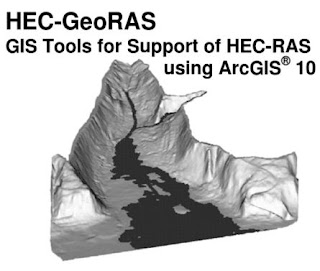HEC-RAS evolution
HEC-RAS is one of the most popular hyodynamic models. it is a freeware that includes a DLL to develop your own script/ codes. In this post I will provide a fast summary of the different versions of HEC-RAS.
Figure 1. User interface of HEC-RAS v1 (Up) and HEC-RAS v5 (Down)
HEC-2 or version 0
In 1968, the U.S. Corps of Engineers released HEC 2, the first American computer program for computing water surface profiles in channels with irregularly shaped cross sections. This program was written in Fortran and was able to calculate water surface elevations by solving the conservation of energy equation with the same iterative method used by HEC-RAS. The user interface was just a console screen with numbers and letters. Alothough it was not officially a HEC-RAS, I mention it as version 0 because its algorithm is the core of HEC-RAS.
Figure 2. User interface of HEC-2.
Source: HEC-2 manual
HEC-RAS Version 1
The first version of HEC-RAS was released in 1995, with a very basic user interface. I have the idea that this basic user interface is a key element for the high popularity of HEC-RAS. It is a simple, yet easy to understand interface. A comparison between the first interface of HEC-RAS and the interface of the newest HEC-RAS shows that there was little change in the interface (Figure 1).
HEC-RAS Version 2
HEC-RAS 2.0 was released in 1997. Then, in the late 1998 HEC-RAS version 2.2 was released. The Federal Emergency Management Agency states that the most significant changes of this version were the corrections in bridge and culvert modeling.
The previous versions of HEC-RAS incorrectly calculated conveyance through bridges and culverts in pressure flow situations. Specifically, the problems occurred in the momentum equation calculations for bridge analysis and in distinguishing between inlet and outlet control situations for culvert analysis.
In general, culverts analyzed with HEC-RAS Version 2.2 under pressure flow will show lower water surface elevations than previous versions of the model. However, bridges analyzed with Version 2.2 under pressure flow generally show higher water-surface elevations using this version compared to previous versions of the model.
The previous versions of HEC-RAS incorrectly calculated conveyance through bridges and culverts in pressure flow situations. Specifically, the problems occurred in the momentum equation calculations for bridge analysis and in distinguishing between inlet and outlet control situations for culvert analysis.
In general, culverts analyzed with HEC-RAS Version 2.2 under pressure flow will show lower water surface elevations than previous versions of the model. However, bridges analyzed with Version 2.2 under pressure flow generally show higher water-surface elevations using this version compared to previous versions of the model.
HEC-RAS Version 3
In January 2001 the HEC-RAS version 3 was released (The first HEC-RAS that I have used). The main innovations of this release were the capabilities to perform unsteady flow simulations and the introduction of GIS with GeoRAS.
HEC-GeoRAS changed the methodology for entering the geometric data and presenting results. Unsteady flow capabilities and GIS capabilities increased the range of applications and changed forever the way of showing results. Now, it was possible to show flood maps instead of just water profiles.
HEC-GeoRAS changed the methodology for entering the geometric data and presenting results. Unsteady flow capabilities and GIS capabilities increased the range of applications and changed forever the way of showing results. Now, it was possible to show flood maps instead of just water profiles.
Figure 3. HEC-GeoRAS
HEC-RAS Version 4
In March 2008 HEC-RAS version 4 was released. The most significant modelling improvements of this version were the capabilities for sediment transport modelling and water quality modelling.
New buttons were included to the graphical user interface: 1 button for quasy-unsteady flow conditions, 2 buttons to enter sediment and water quality boundary conditions and 2 buttons to perform the water quality and the sediment transport simulations. Besides, this was the first version that included the RAS Mapper, which is the RAS own GIS tool. Now, HEC-RAS does not need any external GIS software for showing flood maps.
New buttons were included to the graphical user interface: 1 button for quasy-unsteady flow conditions, 2 buttons to enter sediment and water quality boundary conditions and 2 buttons to perform the water quality and the sediment transport simulations. Besides, this was the first version that included the RAS Mapper, which is the RAS own GIS tool. Now, HEC-RAS does not need any external GIS software for showing flood maps.
HEC-RAS Version 5
In February 2016 HEC-RAS version 5 was released. This was a very expected release. Not only because of the 2D capabilities, but also the release of the beta version in 2015 increased the expectation and the rumors about this new version; the social media and the internet forums were fulled with comments about this new version.
The capability for 2D simulations is a great improvement that increases the range of applications for HEC-RAS. Now HEC-RAS can be used for detailed 2D flood studies and dam break flood simulations.
The first scientific publication using this new 2D capabilities became available also in February 2016 (using the beta version). Personally, it is personal honor to be the author of such publication and I hope that it can be useful for future studies.
The capability for 2D simulations is a great improvement that increases the range of applications for HEC-RAS. Now HEC-RAS can be used for detailed 2D flood studies and dam break flood simulations.
Figure 4. 2D Dam break simulation with HEC-RAS.
The first scientific publication using this new 2D capabilities became available also in February 2016 (using the beta version). Personally, it is personal honor to be the author of such publication and I hope that it can be useful for future studies.

















